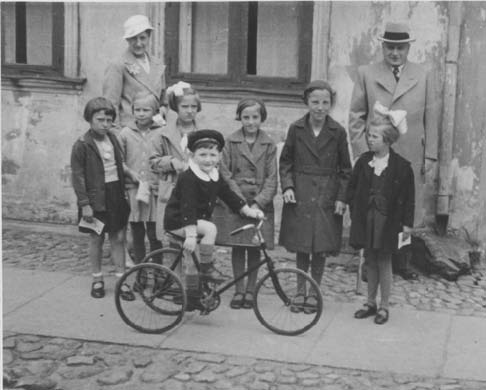January 1945, Poland.
As Soviet forces approach Auschwitz, Nazi soldiers evacuate 60,000 prisoners. Thirteen-year-old Ivar Segalowitz is one of them.
“I remember being on that death march,” he said. “I lucked out again. As horrible as the experience was, I had help. The German soldier, he saw what bad shape I was in. He gave me a piece of bread.”
It was a small act of kindness that helped him survive frigid temperatures.
“He could have been shot for doing that,” Segalowitz said.
Segalowitz would barely survive the Buchenwald concentration camp and live in a French home for boys before making his way to United States – where several years later he joined the army during the Korean War.
“I was drafted, but in those days it was easy to get out of the draft,” he said. “I was liberated in Buchenwald by General Patton’s army. From a very personal standpoint, if not for these people I would have been dead.”
The 81-year-old, who is known to many as chair of the Great Neck Park District Board of Commissioners, will be recognized on Monday, May 30 as grand marshal of Great Neck’s Memorial Day parade.
The parade will begin at 9:30 a.m. on Middle Neck Road.
A grandfather of four, Segalowitz has called the Great Neck peninsula home for nearly 50 years.
“Same house,” he said. “It’s a nice house. We love it.”
Born in Klaipeda, Lituania to a secular Jewish family, as a child Segalowitz spent a lot of time with adults.
“There were three aunts and a couple of uncles,” he said. “I was the only child amongst all of them. That’s a menu for being spoiled.”
When Hitler annexed the seaport town in 1939, they fled to the capital city.
“We were there for about a year when the Russians invaded,” he said.
With an uncle in America unable to arrange visas, they were stuck.
Hitler’s army invaded in 1941.
The Segalowitz family was forced into the camp-like Kovno ghetto, where the 11-year-old boy became a machinist. Sometimes he hid in basements where mothers smothered babies’ cries, but workers usually made it through the frequent life or death selection processes.
It was in a concentration camp where he became a man, bar mitzvahed in a clandestine ceremony that was probably more meaningful to onlookers than to himself. Although he remembers Passover dinners at home, his Hebrew school education had lacked a religious component.
“I am basically a German Jew,” he said.
His Lituanian birthplace changed hands often enough that it had a German name. His mother was born in Germany, where his Russian-born father was educated.
“We had a German maid and she brought me up German,” he said.
It was Germany that took his family.
When the Kovno ghetto was liquidated in 1944, the family was put on cattle cars headed for the concentration camps. He lost his mother and aunt at Stutthof, a concentration camp for women.
The men were taken to Dachau, where Segalowitz was separated from his father and uncle. He never saw them again.
By sheer luck, instead of being assigned to the crematorium, he was sent to a work farm at Auschwitz.
“Horses get a lot of turnips,” he said. “So did we.”
After the infamous death march, he was sent to Buchenwald, one of the largest concentration camps, where prisoners helped maintain Germany’s wartime industries.
“Buchenwald I barely survived,” he said.
Through the intervention of “friends and some adults,” before liberation he was sent to the hospital, which saved his life.
Within six weeks of liberation, he landed at a French home for boys, where he received a telegram from his uncle in America.
“That is how I came to New York,” he said.
With very little education under his belt and no English skills, he graduated from high school with a vocational diploma.
A machinist by day, he attended Stuyvesant High School at night, where he earned an academic diploma. After a tough entrance exam, he was accepted into City College.
His physics degree did not come quickly. In between, 24-year-old Segalowitz married the love of his life, 20-year-old Bernice, had a son and a daughter, and served in the U.S. Army.
Since the camps, life has been easy.
His career was spent in manufacturing, mainly electronics. After his term as park commissioner ends, it is work he hopes to resume as a consultant.
“I was one of the first people to bring some automation into the factory,” he said. “I eventually became a manufacturing executive.”
His pride and joy is a sailboat, a love that goes back to his childhood apartment overlooking the river.
“I always saw boats, and I always wanted to be on boats,” he said. “Finally when I moved to Great Neck I had the opportunity.”
With his wife of 56 years, he has traveled around the country visiting national parks.
“We had a number of things that we wanted to do in life,” he said. “Most of them we’ve done.”
The 87th Annual Memorial Day Parade is scheduled for May 30, rain or shine. Starting at 9:30 a.m. from Middle Neck Road, south of the train station, it will continue north to the Village Green for the Remembrance Service.
The Great Neck Memorial Day Parade Committee invites all to join by viewing the parade along the route up Middle Neck Road to honor fallen veterans. Participating will be The Royal Canadian Legion, Ontario Branch #50.



